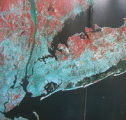About "The Humane Metropolis"™
Today, more urgent than controlling sprawl at the urban fringe is to make "the metropolitan fabric we have already created as green, habitable, and 'humane' as humanly possible."
- R. H. Platt, The Humane Metropolis, Epilogue, p. 321
"Humane Metropolis" Defined:
The "Humane Metropolis" means urban communities at all scales - metro areas, cities, suburbs, neighborhoods, or blocks - that seek to be more:
- Green - protect and restore habitat and ecological services
- Restorative - promote physical and mental health, safety from hazards
- Efficient - conserve energy, water, materials, and time
- Equitable - inclusive, socially and environmentally just
- Neighborly - sense of community, people-friendly, fun!
Some "Humane Metropolis" Strategies:
- Revitalizing Urban Greenspaces - new uses and users
- Urban Ecology - research, restoration, and education
- Urban Watershed Management - stream restoration, daylighting, floodplain and wetland management, waterfront revitalization
- Urban Agriculture - community gardens, vacant lot reuse, farmers markets, youth training
- Environmental and Social Justice - brownfield remediation, air quality improvement, affordable housing, access to jobs
- Green Buildings and Landscaping - LEED standards, energy and water efficiency, stormwater Best Management Practices (BMPs),
Origin and Rationale of "Humane Metropolis:"
The term "The Humane Metropolis" echoes and updates "The Exploding Metropolis", the title of a 1957 book of essays by William H. Whyte, Jane Jacobs, and other "Editors of Fortune Magazine." The Exploding Metropolis challenged two outcomes of America's postwar development boom: "urban sprawl" and "urban renewal." As self-described "people who love cities," the book's authors deplored the replacement of human-scale neighborhoods with bleak housing projects in central cities while farm land and open space were being paved over for monotonous subdivisions on the urban fringe.
Fast-forward to the present. Despite decades of efforts to promote growth management and "Smart Growth," the American metropolis has indeed "exploded." The region named "Megalopolis" by Jean Gottmann in 1961, which then extended from Boston to Washington, DC, today reaches from Southern Maine and New Hampshire to Richmond, VA -  covering parts of thirteen states with nearly 50 million residents. Greater Atlanta now reaches over 110 miles north to south, as compared with 65 miles in 1990. Both coasts of Florida are solidly lined with metropolitan areas. Metropolitan Los Angeles is spilling eastward into the Mojave Desert. Irrigated farms of California's Central Valley are disappearing under buildings and pavement.
covering parts of thirteen states with nearly 50 million residents. Greater Atlanta now reaches over 110 miles north to south, as compared with 65 miles in 1990. Both coasts of Florida are solidly lined with metropolitan areas. Metropolitan Los Angeles is spilling eastward into the Mojave Desert. Irrigated farms of California's Central Valley are disappearing under buildings and pavement.
Four-fifths of Americans now live in the nation's sprawling metropolitan areas (see diagram) and half of the world's population for the first time is now classified as "urban."
Some notable victories in the battle against sprawl have been won involving significant sites, landscapes and bioregions such as:
- Sterling Forest - critical to protecting drinking water for one-quarter of New Jersey's residents
- The Indiana Dunes National Lakeshore near Chicago
- The Metro Portland (Oregon) Regional Greenspaces System
But the prevailing pattern of metropolitan growth since the 1950s has fulfilled the worst fears of "The Exploding Metropolis" authors. The battle against sprawl has been widely, if not universally, lost. More urgent today than controlling sprawl at the urban fringe is to make "the metropolitan fabric we have already created as green, habitable, and'humane' as humanly possible." (R. H. Platt, The Humane Metropolis, Epilogue, p. 321).
HM Book, Conferences, and Public Talks:
"The Humane Metropolis" was first coined by Dr. Rutherford Platt as the name of a 2002 symposium in New York City organized by the Ecological Cities Project at the University of Massachusetts-Amherst with support from the Lincoln Institute of Land Policy in Cambridge, MA, the late Laurance S. Rockefeller, the Wyomissing Foundation, and the National Park Service Rivers and Trails Program. In 2006, the University of Massachusetts Press and The Lincoln Institute co-published The Humane Metropolis: People and Nature in the 21st Century City edited by Dr. Platt, and including a DVD created by Ted White. (This book is a sequel to Dr. Platt's earlier edited book: The Ecological City: Preserving and Restoring Urban Biodiversity (University of Massachusetts Press, 1994).
Dr. Platt has given book talks on "The Humane Metropolis" in Cambridge, MA, New York City, Chicago, Portland OR, Los Angeles, Istanbul, and other cities. The Lincoln Institute and the Ecological Cities Project are holding a series of regional "Humane Metropolis" public workshops beginning in Pittsburgh in March 2007 and continuing in Riverside, CA on January 24, 2008.



